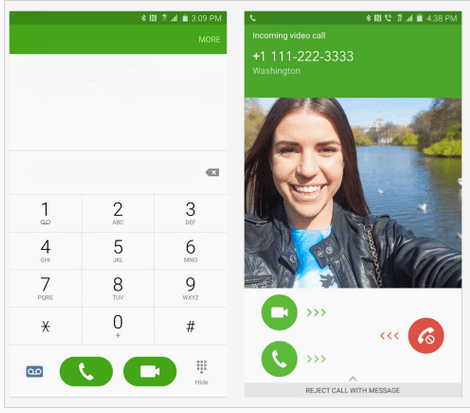There are a number of apps that let smartphone users make video calls today, including Skype, Facebook Messenger, Google Hangouts and more, as well as built-in apps like Apple’s FaceTime, for example. But this morning, mobile carrier T-Mobile announced plans to make video calls a native feature on select T-Mobile smartphones.
The company says it will roll out the feature to the Samsung Galaxy S6 Edge+ and the Samsung Galaxy Note 5 starting now, while the Galaxy S6 and Galaxy S6 Edge will see the addition arrive next week. With T-Mobile Video Calling, the idea is to basically offer Android device owners something that feels more native to the user experience, in order to better compete with things like Apple’s FaceTime, for example.
To get the feature, owners of supported Samsung devices are instructed to download the update by going to their Settings, then “About Device,” then “Software Update.” Once installed, small camera icons will appear next to contacts who are able to receive video calls, explains T-Mobile.
For the time being, this option will only work across T-Mobile’s network, though the carrier notes it’s “working with others” to bring the option to make video calls across networks. That could indicate that T-Mobile plans to partner with Verizon, which introduced HD Voice and video calling last year. Like Verizon’s solution, the option to kick off a T-Mobile video call is integrated into the phone’s dialer.
Video calling works over LTE and Wi-Fi, and can move seamlessly between the two as T-Mobile’s HD Video calls do. The feature will also seamlessly switch over to a voice call when a user moves to a slower connection. And if they return to an LTE or Wi-Fi connection, they can then enable a video call again with a tap, T-Mobile claims.
But because of the limited number of devices supported at launch and the restrictions that only allow it to work on the T-Mobile network, native video calling is not likely to be a feature that’s immediately adopted by a large number of T-Mobile users. However, T-Mobile’s plan is to roll out support for more devices quickly, it says. By year’s end, it will have seven total devices that offer video calling.
The debut of native video calling follows a number of other upgrades T-Mobile has introduced in recent months, including its VoLTE rollout and this July’s launch of “Advanced Messaging,” for example. This gave customers a more iMessage-like experience that includes typing indicators, read receipts, and the ability to share photos and videos up to 10 MB.
















